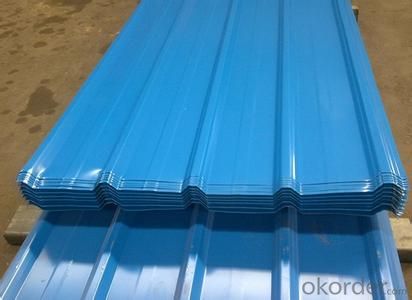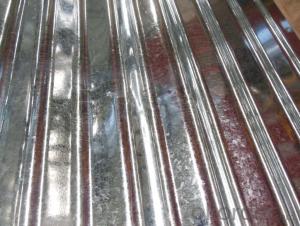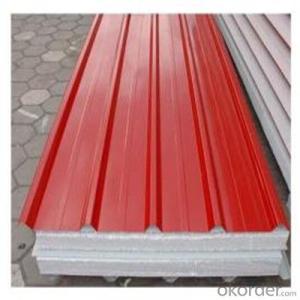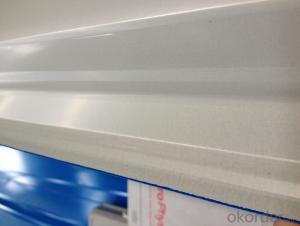COLOR COATED GALVANIZED STEEL CORRUGATED SHEETS
- Loading Port:
- Tianjin
- Payment Terms:
- TT OR LC
- Min Order Qty:
- -
- Supply Capability:
- 10000 m.t./month
OKorder Service Pledge
OKorder Financial Service
You Might Also Like
COLOR COATED GALVANIZED STEEL CORRUGATED SHEETS
THICKNESS:0.26mm
1.WIDTH:820mm (0/+5mm, AFTER CORRUGATION)
2.LENGTH:3000mm (0/+5mm), 5800mm (0/+5mm)
3.ZINC COATING:60g/m2
4.STANDARD:JIS G 3312, CGCC (SOFT QUALITY)
5.TOP COATING:5+15 MICRON(POLYESTER); BACK COATING:5-7 MICRON (EPOXY),LIGHT GREY
6.COLOR:AS PER RAL CARD
7.PACKAGE WEIGHT:3-3.5tons/BUNDLES
8.TOLERANCE: -/+5 % TOLERANCE WITH QTY AND AMOUNT (THICKNESS:-/+0.02mm; WIDTH:0/+5mm; ZINC COATING:-/+10g/m2; COATING MASS THICKNESS:-/+ 2 MICRON)
9.PAYMENT TERM:30% TT advance,70% against BL copy OR 100% LC AT SIGHT.
10.SHIPMENT: WITHIN 35 DAYS AFTER RECEIVING THE DEPOSIT.
11.DOUCUMENTS:COMMERCIAL INVOICE IN THREE ORIGINAL,PACKING LIST IN ONE ORIGINAL AND SPECIFICATION,CERTIFICATE OF ORIGIN.
- Q: Can steel sheets be used for medical equipment?
- Yes, steel sheets can be used for medical equipment. Steel is a durable and hygienic material that is often used in the manufacturing of medical instruments, surgical tools, and equipment due to its strength, corrosion resistance, and ease of sterilization.
- Q: Are steel sheets suitable for fire-resistant applications?
- Yes, steel sheets are suitable for fire-resistant applications. Steel is known for its excellent fire resistance properties. It has a high melting point and does not easily ignite or contribute to the spread of fire. Steel sheets can be used in various fire-resistant applications such as fire doors, fire-rated walls, and fireproof enclosures. Additionally, steel sheets can be combined with other fire-resistant materials, such as fire-resistant coatings or insulation, to further enhance their fire resistance. Overall, steel sheets are a reliable choice for fire-resistant applications due to their durability, strength, and ability to withstand high temperatures.
- Q: Do the steel sheets have any sharp edges?
- Yes, steel sheets often have sharp edges due to the manufacturing process and their intended purpose.
- Q: Are the steel sheets suitable for architectural cladding?
- Steel sheets are indeed appropriate for architectural cladding. Steel, being a sturdy and long-lasting substance, offers outstanding defense against weather conditions and external influences. It is easily malleable and can be crafted into diverse shapes, making it extremely adaptable for architectural purposes. Moreover, steel cladding provides a contemporary and polished appearance, permitting the creation of visually captivating building exteriors. Additionally, steel sheets can be coated or painted to augment their ability to resist corrosion and to further personalize their look. All in all, due to their strength, durability, versatility, and aesthetic allure, steel sheets are widely favored for architectural cladding.
- Q: Can steel sheets be used for making furniture?
- Yes, steel sheets can be used for making furniture. Steel is a versatile material that offers several advantages when used for furniture construction. It is known for its strength, durability, and ability to withstand heavy loads. Steel sheets can be shaped, welded, and fabricated into various furniture pieces such as tables, chairs, cabinets, and even bed frames. Additionally, steel furniture tends to be resistant to rust and corrosion, making it suitable for both indoor and outdoor use. The sleek and modern aesthetic of steel also adds a contemporary touch to any space.
- Q: Are the steel sheets suitable for food-grade applications?
- Yes, steel sheets can be suitable for food-grade applications. Stainless steel in particular is commonly used in the food industry due to its excellent corrosion resistance, durability, and ease of cleaning. It is non-reactive and does not release any harmful substances into food, making it a safe choice for food storage, processing, and transportation. Additionally, stainless steel is resistant to high temperatures and can withstand rigorous cleaning and sanitization processes, making it ideal for use in food-grade applications. However, it is important to ensure that the steel sheets meet the necessary food-grade standards and regulations before using them in any food-related setting.
- Q: How do steel sheets perform in terms of electrical conductivity?
- Steel sheets are generally poor conductors of electricity due to their high resistance.
- Q: Is the cold rolled steel plate good or the stainless steel plate?
- The cold rolled steel itself, whether washed by acid car wash, semi-finished products, or rolled out by cold rolling mill semi-finished products, their rust resistance is very poor. It is easy to oxidize, resulting in rust on the surface of the air. It will not rust until it has been plated with aluminum or zinc, and it is clear that the process is complex and unsafe.
- Q: What are the different surface treatments for steel sheets?
- Steel sheets offer a range of surface treatments, each designed for specific purposes and offering unique advantages. Some commonly used treatments include: 1. Hot-dip galvanizing: Immersing the steel sheet in molten zinc forms a protective layer, providing excellent corrosion resistance. This treatment is ideal for outdoor applications like roofing, fencing, and automotive parts. 2. Electroplating: Using an electric current, a thin layer of metal such as chromium, nickel, or zinc is deposited onto the steel sheet. Electroplating enhances the appearance, corrosion resistance, and can improve wear resistance. 3. Powder coating: Dry powder is applied to the steel sheet and then baked to create a durable, smooth, and uniform finish. Powder coating offers excellent corrosion and impact resistance, and comes in various colors and textures, making it suitable for architectural, automotive, and appliance uses. 4. Painting: Applying paint to the steel sheet provides aesthetic appeal and protects against corrosion. Different types of paints, such as epoxy, polyurethane, or acrylic, can be used based on desired appearance and environmental conditions. 5. Passivation: This chemical treatment removes impurities and contaminants from stainless steel sheets, improving their corrosion resistance against oxidation and staining. 6. Electropolishing: By immersing the steel sheet in an electrolyte bath and applying an electric current, a thin layer of material is removed, resulting in a smoother, brighter surface that is more resistant to corrosion. These examples demonstrate the variety of surface treatments available for steel sheets. The most suitable treatment depends on factors like intended application, desired appearance, corrosion resistance requirements, and budget. Seeking advice from a steel sheet supplier or surface treatment specialist can help determine the optimal treatment for specific needs.
- Q: Can steel sheets be used for construction formwork or molds?
- Certainly, construction formwork or molds can utilize steel sheets, although their usage may not be as prevalent as materials like plywood or timber. Robust and enduring, steel sheets offer a sleek and uniform surface for concrete casting. They prove especially fitting for expansive construction ventures demanding formwork capable of withstanding immense pressures and loads. Additionally, steel sheets can be tailor-made and manufactured to meet precise project specifications, affording versatility in terms of shape, size, and arrangement. Nevertheless, the cost, weight, and accessibility of steel sheets should be weighed against alternative formwork materials prior to reaching a verdict.
Send your message to us
COLOR COATED GALVANIZED STEEL CORRUGATED SHEETS
- Loading Port:
- Tianjin
- Payment Terms:
- TT OR LC
- Min Order Qty:
- -
- Supply Capability:
- 10000 m.t./month
OKorder Service Pledge
OKorder Financial Service
Similar products
Hot products
Hot Searches
Related keywords



























